If so I got my first good look at those marvels of biological engineering three days ago.
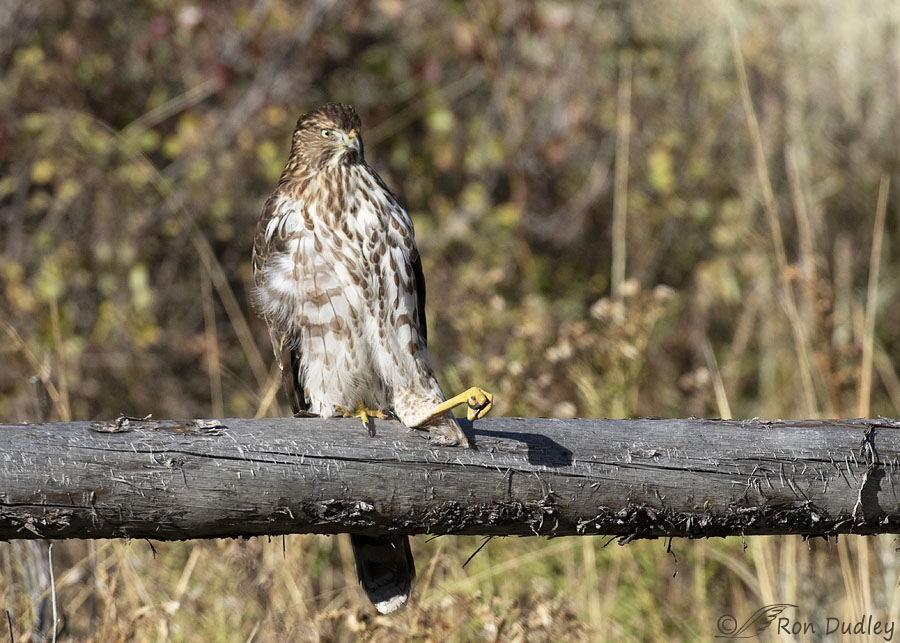
Followers of Feathered Photography already know that four days ago I spent 24 minutes up close with an unusually “tame” Cooper’s Hawk. But these photos were taken the next day in the same place in the mountains and this time I spent a whopping 1 hour and 20 minutes with the same bird! Now you see why I refer to “him” as the tamest Cooper’s Hawk I’ve ever encountered.
But in those 80 minutes he never moved an inch off of his original spot on the perch. It was early morning and very cold so I think he was just trying to warm up in the sun. The only pose variety he gave me was a few stretches like this leg stretch…
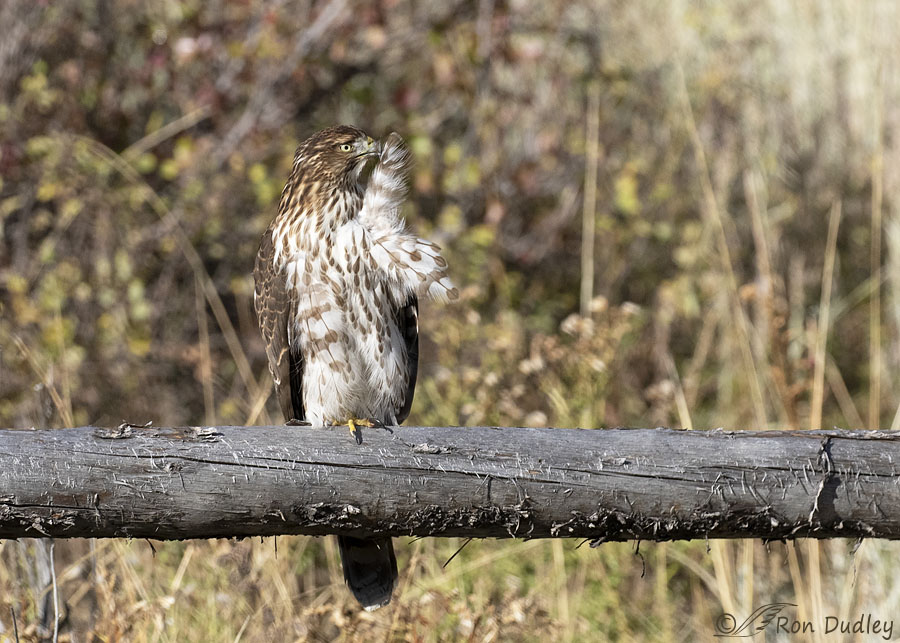
some interesting preening poses…
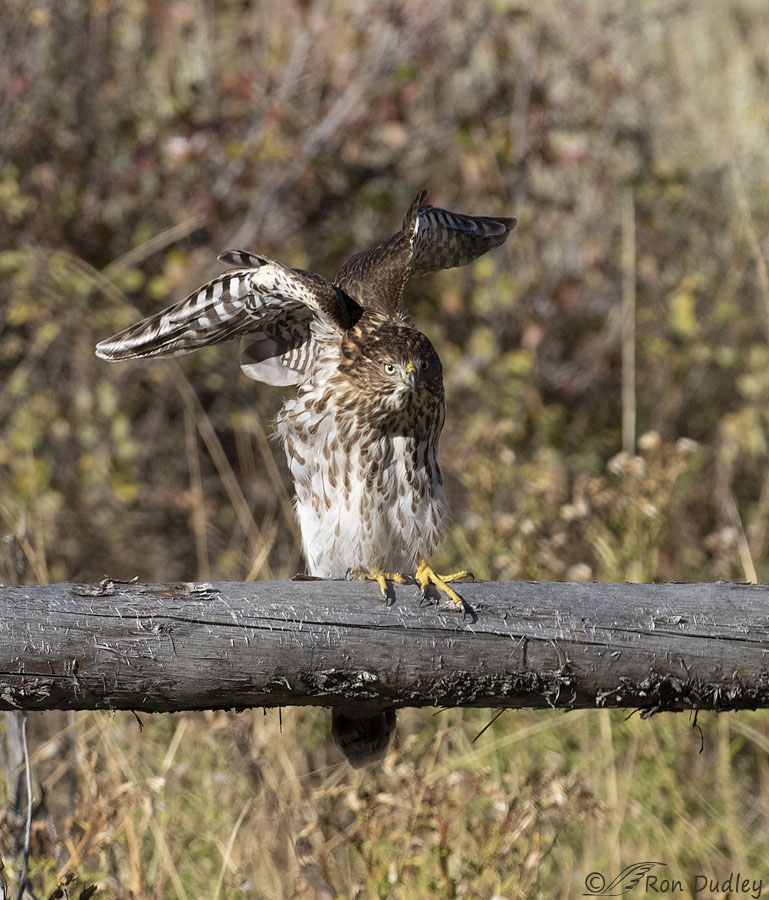
and a bilateral wing stretch. Eventually I got tired of taking mostly similar shots of him and drove down the road looking for other birds. Besides my camera battery was about dead from laying on the focus button for so long (I use back-button focus).
Ok, what does this bird have to do with nostril baffles?
This is a big crop of an older photo of a female Prairie Falcon cleaning her messy feet after a huge meal of duck that obviously gorged her crop. We can clearly see her right nostril baffle so typical of falcons.
It’s well known that falcons fly incredibly fast so they have bony cone-shaped baffles just inside their nostrils that are believed to disrupt the air flow and reduce the pressure of air rushing into the their nostrils and lungs. Humans actually copied that cone-shaped design in our modern jet engines. As jet aircraft became faster and faster the engines started choking out because at those speeds the air largely bypassed the air-breathing engine. Engineers found the solution by looking at the nostril cones of Peregrine Falcons. As a result modern jet engines have a metallic cone in front of the engine to disrupt the airflow and allow the engine to “breathe” more efficiently.
But do accipiters like Cooper’s Hawks also have baffles in their nostrils? I always thought baffles were exclusive to falcons but I believe I remember one of my falconer blog followers (Laura Culley?) saying several years ago that at least some hawks have softer, non-bony structures inside their nostrils that have the same function as bony falcon baffles. Until three days ago I’ve never been able to confirm their presence in Cooper’s Hawks because they’re so elusive around here (you have to be very close to see nostril baffles) and because the light angle into the nostril has to be just right.
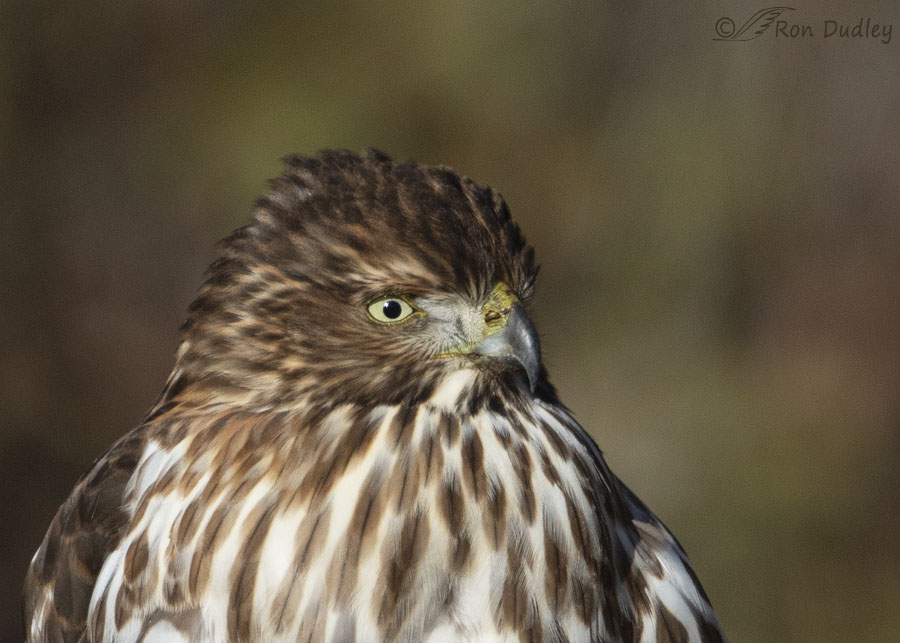
But the same cooperative Cooper’s Hawk in the first three photos above turned its head just right to the sun to reveal what looks to me like a nostril baffle. Or something very similar.
But if Cooper’s Hawks (and possibly other hawks) have nostril baffles why can’t I find anything about them when I attempt to research them online? I always come up empty. Maybe they have a different name because they’re non-bony or perhaps what I’m seeing here isn’t a baffle at all?
Some of my blog followers (falconers, rehabbers, avian researchers and others) are extremely raptor-knowledgeable. I’d love to be enlightened…
Ron
Late Addendum: I believe the “mystery” may have been solved. Please see Mikal Deese’s first comment thread below for the full explanation.


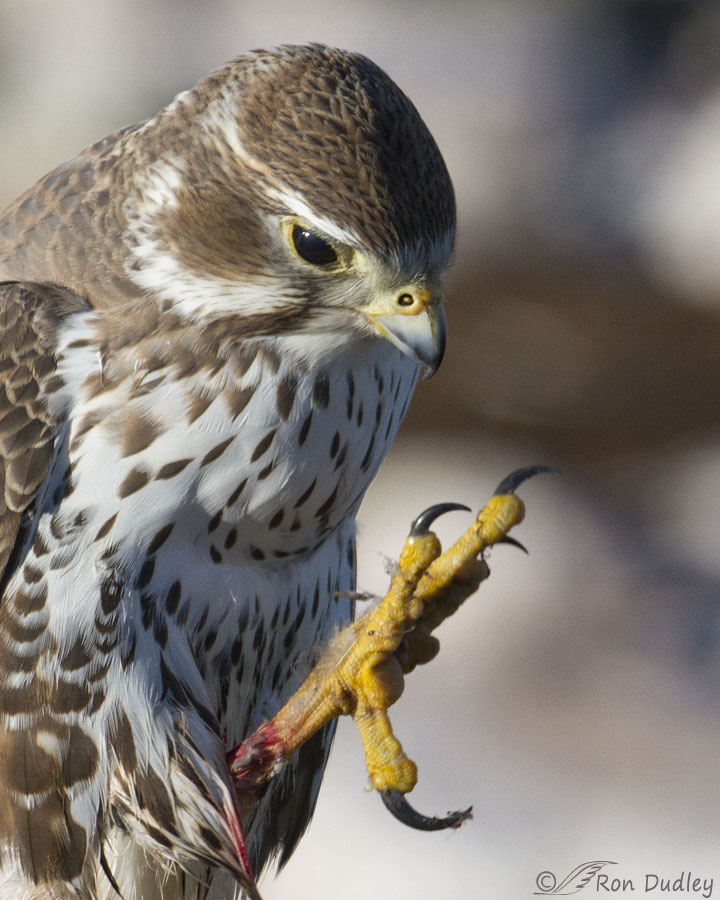
I appreciate that you noticed and posted this nares phenomenon. The conversation has been very educational. Thanks to all and hope the hawk thrives.
Thank you, Lyle.
Rhinoliths!
Sheesh, I knew this life was fraught with hazards but of this I knew not.
Fascinating series, hats off to you Ron and your impressive supporting cast.
It’s fun to learn that stuff, isn’t it Dave. “Nose stone”, literally.
I guess pickin’ one’s nose serves a useful purpose. Get those boogers before they get hard…
Thank you and your knowledgeable commentators. I have learned (again) but my worry level also rose. I do hope the young hawk is ok.
Thanks, EC. I’m in the learning category too, thanks to my blog followers.
One more bit of info that I rarely get to work into conversations: the mucus secretions occasionally dry and harden to become “rhinoliths”. . In short, the booger becomes a solid larger than the opening to the nare, can block airflow, and must be surgically removed. I’ve seen them in parrots with respiratory issues. Lord, I can’t believe I know these things. And now you all know it too!
I’m glad you know them, and share them, Mikal. Please see my latest reply to your comment below.
I know they are incredibly fast flyers. Perhaps it is for the same reason. It is an accipiter so maybe that’s a part of it?
Could be, Arwen. I just don’t know.
He’s channeling his “inner penguin” (or Charlie Chaplin, if we’re going to stay with yesterday’s old movie theme) in the first pose.
After reading Louise’s and Mikal’s comments, I’m now a bit worried for him. Hope he’s able to find some food.
Marty, I looked for him this morning in the same spot but there was no sign of him. That could be either good or bad.
Hopefully, it means he’s off on an adventure — one involving lots of snacks.
I happened to see your post while I was holding a young Coop that came into rehab yesterday. I can reliably report that you’re seeing a Coop Booger, not the structure in a Falcon’s nare. It’s the season for “failure to launch”, the diagnosis for a youngster that doesn’t have his hunting skills refined yet. The one in my lap was found yesterday so skinny that she’s unable to fly. Also, being a hyper bird, she is too freaked to feed herself in captivity. Forced liquids yesterday, so sitting here feeding solids this morning. Another few hours and she’ll figure out that it’s better to eat voluntarily. Once she’s gained weight and strength, she’ll be fine to give life out there another try. Boogers are transitory.
Mikal, I considered that booger possibility and discarded it. I guess I shouldn’t have.
I’ll look carefully at the photos I took of this bird on the previous day and see if I can find evidence either way. If I do I’ll post the photo here, probably as an addendum to my post.
I’ve had the unique opportunity to clean out hawk’s boogers, occasionally songbird boogers too. Oh, the intimate things you get to experience in rehab!I learn so much from you. Glad to be able to supply you with an answer for once!
Mikal, I’m not seeing it in either nostril in photos I took the day before. Even though those photos don’t show quite as much detail I’m fairly confident that you’re right – it’s nothing more than a “booger”. The only thing that makes me slightly dubious is the fact that the “booger” is the same color as the bill. Coincidence? Thank you.
Two things: yes, that structure in the nare looks familiar to me,and though I can’t definitively say it serves the same function (accipiters are fast in the sense of twisting and turning chases rather than the high-speed dives of the large falcons). But I think it’s there and I just haven’t focused on it. Not helpful, I’m sure.
BUT I also wanted to say that I, too, would worry about this Coop. The last photo shows an almond-shaped eye that we see in starvation/dehydration/debilitation cases. This young bird may not be doing well and that’s why he tolerated you for so long – conserving his energy and warming up because he was weak. Physiologically, he CAN fly but he may not have the strength. Unfortunately, now is the time of the year that we rehabilitators we see this a lot in juveniles who just aren’t making it on their own. Well over half – and in some species as high as 70 or 80 – don’t make it through their first winter. I hope he was just squinting in the sun …
Very interesting comment Louise.
I’ll look for the almonds-shaped eye in my other photos of this bird over two days.
Well, being an old biology teacher you had to bring the subject into the Feathered blog. Brings back painful memories of my high school youth. Just kidding of course Ron. Today reading information such as you have presented here is one of my favorite things. Becoming interested in birds and nature in general years ago changed my whole outlook on biology and science. My knowledge is insufficient to comment on your questions here, but I am sure some of my Audubon member friends here in Prescott can. Thanks for posting this Ron – and of course great photos as always.
That’s like me with a different subject, Everett. I used to despise history but now I’m a huge fan.
A situation to be lucky (?) to occasionally have…unlimited time, good lighting, natural background but an un-enthusiastic model! Boredom doesn’t happen very often when out with raptors. I envy you the opportunity. What you have are great natural actions. It will be interesting to see what answers you may learn in regards to the ‘baffle mystery’…looking forward to learning more…
What you have are great natural actions. It will be interesting to see what answers you may learn in regards to the ‘baffle mystery’…looking forward to learning more…
Kathy, I’m not sure I was bored. It was more like me needing some variety in what I was doing. It’s very difficult to concentrate intensely for that long while looking through the viewfinder and keeping a trigger finger on the shutter button to get flight shots in case he took off. After that long it just becomes too much, especially since he wasn’t usually doing much of anything…
I don’t know about you but when I sit looking through the viewfinder for a great length of time my eye begins to dry, itch, so then I’ll blink a bit and close my eyes a second and then find the subject did something in that split second I blinked! Can be frustrating.
Exactly.
Wow! What a long Cooper’s session. Looks like a bifurcated baffle to me. The shape reminds me of a barnacle, so I’ll call it a barnacle baffle. I just checked a very sharp close-up photo I took of a Red-tailed and I see no sign of any baffle, granted that the light angle is not perfect but there is no hint of such a structure. 80 minutes, got bored and left, what a nice luxury to encounter. One in a million. Nice work and thanks for furthering our education. Hope we entertain you well enough in return.
Dave, for a while I actually wondered if something might be wrong with that Coop but I’m convinced he was fine and just warming up in the sun. Temps were in the 20’s that morning and that area had been in shade from nearby mountains until not too long before I got there so I’m sure he was cold. All his stretching activities seemed to be normal and the previous day he could (and did) fly normally.
“Continuing Education” What appears to be the baffle is very different from the one on the falcon – doesn’t mean it isn’t one and would certainly limit air flow. Hope someone can enlighten all of us…..
What appears to be the baffle is very different from the one on the falcon – doesn’t mean it isn’t one and would certainly limit air flow. Hope someone can enlighten all of us…..  Beautiful shots – almost thought the leg in the first shot was injured! Shows what I know….
Beautiful shots – almost thought the leg in the first shot was injured! Shows what I know…. 
“almost thought the leg in the first shot was injured”
Judy, that leg position is actually pretty common in at least some raptor species. I see it fairly often with red-tails.
WOW! I am just awed by the pictures and the fact that this hawk was unconcerned about you for over an hour! I know they are arrogant, s show-off and very aware, but to let a human click away for an hour, amazing!! Absolutely beautiful images.
Wish I could help, but I always felt that both Falcons and Hawks had a type of nostril baffle. Definitive information would be great!
Many thanks for sharing.
Dick, I was blown away by how long he tolerated me. I think he likes me…
I agree!